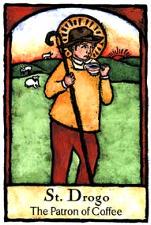A few days ago, a Texas teacher was
escorted from her classroom after proclaiming that she was married to God, who
was going to destroy the world Dec. 12. However,
she assured the students that Jesus had set up another planet where they would
be always 25 years old and where money did not exist.
According to officials there, the
teacher was not having a revelation, but may have had an adverse reaction to medication.
Not that long ago, any teacher making
such proclamations would have been made into a saint and an object of
veneration. Instead, now, she was
assumed to be ill. Another religious
figure, Eddie
Long, the pastor of a Georgia-based church, was recently wrapped in a Torah and
declared king. He was laughed at by the
media and was forced to offer a stumbling explanation.
Think of St. Drogo, for
example. Saddened that his mother died
in childbirth, he launched a career of self-flagellation in the 1100s. On one of his many pilgrimages to Jerusalem,
the Frenchman came down with a disease that deformed him. As a result, he was hidden away and yet
revered. Today, he’s the patron saint of
coffee houses.
St. Anthony, an Egyptian Coptic
monk, lived in a tomb for many years, he said, to overcome “boredom, laziness
and the phantoms of women.” He drew
large crowds of admirers until his death around 356.
 |
| St. Hildegard |
St. Hildegard, who died in 1179,
wrote that “… it
came to pass...when I was 42 years and 7 months old, that the heavens were
opened and a blinding light of exceptional brilliance flowed through my entire
brain.” Too much medicine for her, too?
Let’s
not forget St. Joseph, the one who lived in the 1600s. He was seen flying. He also supposedly able to command animals, a
particularly valuable skill in case something like a hungry eagle saw him
airborne.
Back
in the 5th century, St. Simeone Stylites lived for decades on top of
a pillar near Aleppo, Syria. People
crowded around his pillars, seeking advice and blessings from the would-be
hermit.
Such
absurdities are not limited to Catholics.
Zany activity went on in many other
beliefs as well.
In the light of the odd behavior of
religious zealots, what happened in Texas would seem perfectly normal.
In some ways, it is. People often feel the need to express their
religious feelings in bizarre ways for several reasons:
They want to show they are true
believers. The skepticism exists within
their own brains. They are trying to
convince themselves. The pain they often
endure helps ease the psychological emptiness.
They are simply not happy with themselves. As one drug addict noted, “No matter what I
did, what I said, where I went, I was never comfortable with the shell I
carried called myself.” For some,
religion becomes the drug of choice.
In addition, they have swallowed the
religious teachings of heaven and hell with amazing relish and are desperate to
ensure their own passageway to God’s home.
Philosophies of religion can become so ingrained that they dictate
behavior, much the same way parasites can force animals to perform bizarrely.
 |
| Mass suicide at Jonestown |
Also, they want to demonstrate they
belong to the group. Mob psychology
helps explain group suicides, like what happened in Guyana with Jim Jones in
1978 or Heaven’s Gate in 1997. In both
cases, many people willingly committed suicide.
Acting independently, many probably would not have, but were carried
along by the group to “prove” their commitment.
Ego gets involved, too. People who are immersed in their faith feel
obligated to demonstrate the depth of their commitment. After all, they are being compared to other
religious figures from the past and present.
If one "saint" prayed eight hours a day, the next must at least match that, and
so on.
Then, too, some people have brain
damage or cause their own problems by severely limiting their diets. Saints are especially famed for their sparse
menus. However, lack of food leads to
hallucinations. Native Americans took
advantage of that fact to send their young male adults off into the
wilderness. They would get very hungry,
causing dreams that, in turn, resulted in assuming new, adult name.
Psychiatrists undoubtedly can come
up with other answers. However, the
differences between yesterday and today are starkly obvious: what used to be
considered religious revelation is today thought of as a mental aberration.
That’s how far modern skepticism has
overtaken aging religion.
Long-time religious historian Bill
Lazarus regularly writes about religion and religious history. He also speaks at various religious
organizations throughout Florida. You
can reach him at www.williamplazarus.com. He is the
author of the famed Unauthorized Biography of Nostradamus; The Last Testament of Simon
Peter; The Gospel Truth: Where Did
the Gospel Writers Get Their Information; Noel: The Lore and Tradition of Christmas Carols; and
Dummies Guide to Comparative Religion. His books are available on
Amazon.com, Kindle, bookstores and via various publishers. He can also be followed on Twitter.


No comments:
Post a Comment